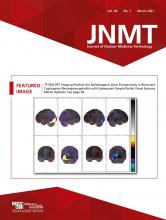Abstract
18F-FDG PET scans have proven to be useful in the diagnosis and management of encephalitis patients. 18F-FDG PET scans are also the standard of care in the evaluation of epilepsy patients before surgery. Encephalitis patients who later develop epilepsy may have useful imaging findings at the time of diagnosis. We present a case of 18F-FDG PET imaging in a patient with recurrent cryptogenic meningoencephalitis. 18F-FDG PET imaging after resolution of the encephalitis revealed hypometabolism in previously hypermetabolic areas. Hence, the initial 18F-FDG PET scan prospectively predicted the epileptogenic zone and seizure-onset zone.
This case considers the utility of 18F-FDG PET in characterizing acute encephalitis and describes findings predictive of the development of seizures.
CASE REPORT
We present a woman with recurrent cryptogenic biopsy-proven meningoencephalitis starting at 40 y old, who later developed simple partial visual seizures. 18F-FDG PET scans were performed for evaluation of the encephalitis and of subsequent medically intractable seizures (which developed within 6 mo after encephalitis) in the interictal and ictal phases. These scans were performed within 12 mo of each other. The scans were analyzed and compared with a reference database (Fig. 4), and z scores were generated using MIMneuro software (MIM Software Inc.). During the episode of meningoencephalitis, intense hypermetabolism was noted in the left temporooccipital region, and hypometabolism was noted in the left temporoparietal region (Fig. 1A). There was also increased 18F-FDG uptake in the limbic structures. 18F-FDG PET imaging 2 mo after the initial encephalitis revealed hypometabolism in the left temporooccipital region, with persistent hypermetabolism in the limbic structures (Fig. 1B). After the clinical development of seizures, interictal and ictal imaging delineated areas of hypometabolism in the left temporooccipital region (Figs. 2 and 3). Hypometabolism noted on the ictal PET scan was less intense than that noted on the interictal scan. Subtraction imaging demonstrated a relative increase in 18F-FDG uptake ictally, when compared with the interictal scan (Figs. 3A and 3B). The seizure-onset zone was in the left occipital region, similar to the hypermetabolic area noted during the initial encephalitis episode (Fig. 1A).
18F-FDG PET metabolic z score cortical surface map projections compared with healthy controls. (A) Encephalitis episode. (B) Two months after encepahilitis.
18F-FDG PET for epilepsy. (A) Stereotactic-surface-projection interictal scan. (B) Interictal z score cortical-surface-map projections compared with healthy controls.
18F-FDG PET for epilepsy. (A) Stereotactic-surface-projection ictal scan. (B) Subtraction ictal–interictal scan showing significant cluster for seizure-onset zone in left occipital lobe.
Healthy control stereotactic-surface-projection comparison.
DISCUSSION
Encephalitis is a relatively rare condition for which making an accurate diagnosis can be challenging. Clinical features are not specific, and MRI findings can be normal in a considerable number of cases (1,2). Early diagnosis is important, as many forms of treatment are effective if started promptly. 18F-FDG PET has been used successfully in MRI-negative or MRI-inconclusive cases of encephalitis (2–5). It frequently manifests as hypometabolism, but focal cortical hypermetabolism can also be observed (2–5). 18F-FDG PET imaging also shows, in a relevant number of patients, extralimbic metabolic abnormalities (mainly in the brain stem, cerebellum, or cerebral cortex). These PET findings are associated with clinical symptoms and active disease status more strongly than are the MRI findings. 18F-FDG PET has the potential to improve estimation of disease severity in patients with autoimmune encephalitis, with implications for follow-up evaluation and therapy monitoring.
On the other hand, 18F-FDG PET is also used to delineate the epileptogenic zone and seizure-onset zone in patients with medically refractory epilepsy. Traditionally, once seizures have occurred for a certain period, 18F-FDG PET scans can help determine the surgical eligibility of a patient. However, our case demonstrated how 18F-FDG PET could prospectively predict the seizure-onset zone as an area of hypometabolism in the previously hypermetabolic area of the initial encephalitis. This finding was noted before the patient developed seizures. Seizure-onset-zone hypometabolism worsened with time after clinical seizure development. Consideration of all findings on an 18F-FDG PET scan during the encephalitis episode and the recovery period may help in clinical management and close monitoring of these patients. Patients who have cortical hypermetabolism that converts to hypometabolism and does not normalize may be at a higher risk of developing intractable seizures later. This possibility can help in guiding new treatment approaches. However, further exploration and validation is needed in a larger cohort of encephalitis patients undergoing 18F-FDG PET.
CONCLUSION
18F-FDG PET of encephalitis patients may help in the management of medically refractory cases of epilepsy by prospectively predicting the seizure-onset zone.
DISCLOSURE
No potential conflict of interest relevant to this article was reported.
Footnotes
Published online Nov. 20, 2020.
REFERENCES
- Received for publication July 2, 2020.
- Accepted for publication August 18, 2020.











